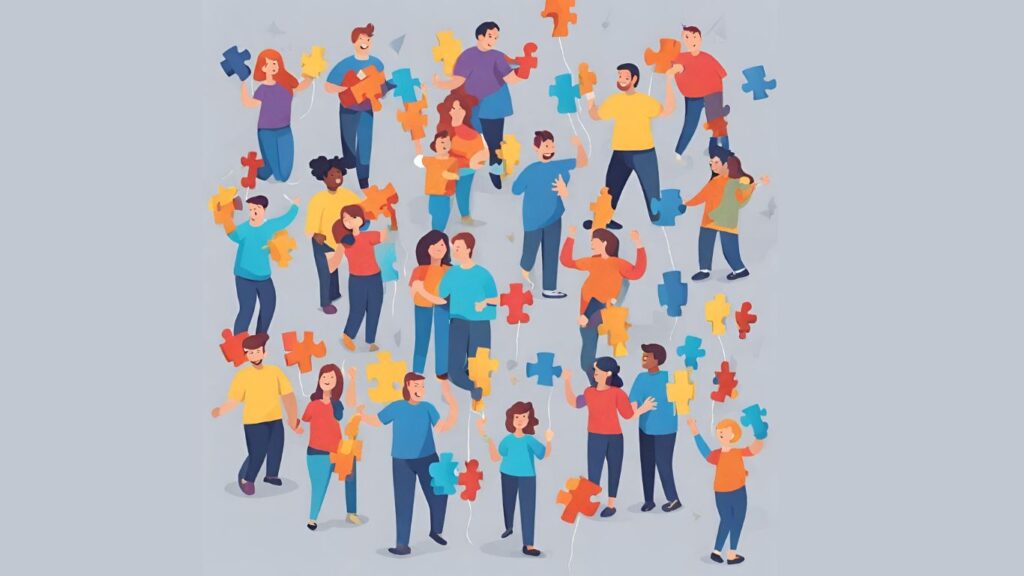Autism spectrum disorder (ASD) is characterized by challenges with social skills, repetitive behaviors, speech and nonverbal communication. However, there is a wide variation in the type and severity of symptoms people with ASD experience. To help categorize these differences, autism is often divided into three levels based on the amount of support a person needs.
What Are the Levels of Autism?
The autism spectrum isn’t a straight line – it’s more like a colorful tapestry with different patterns and intensities. But to make things easier, experts have come up with three main levels.
Level 1: “Requiring Support”
This is what people used to call “high-functioning” autism. Folks at this level can communicate verbally and handle many daily tasks on their own. But social situations? That’s where things get tricky.
These individuals might struggle with:
- Starting conversations
- Maintaining back-and-forth chats
- Reading social cues
- Adapting to changes in routine
They’re independent in many ways, but some extra support can make a big difference in their social lives and daily functioning.
Level 2: “Requiring Substantial Support”
Moving up the scale, we’ve got Level 2. Here’s where communication challenges become more noticeable. People at this level might:
- Use limited verbal communication
- Struggle with nonverbal cues
- Have very specific interests that can interfere with social interactions
- Show obvious difficulty coping with change
They’ll need more help in daily life, especially when it comes to social situations and adapting to new environments.
Level 3: “Requiring Very Substantial Support”
This is the most intense level of autism. Individuals here face significant challenges in communication and behavior. They might:
- Have little to no verbal communication
- Struggle with nonverbal communication too
- Show repetitive behaviors that interfere with daily functioning
- Have extreme difficulty coping with change or unexpected events
People at this level need constant support and supervision to navigate daily life.
Level 1 Autism
Individuals with Level 1 Autism, also known as high-functioning autism, generally have milder symptoms that require less support. They can speak and have average or above-average intelligence.
Some common traits of Level 1 Autism include:
- Ability to speak fluently with well-developed language skills. May have advanced vocabulary for their age.
- Strong focus and concentration on topics of interest. Extensive knowledge in niche subjects.
- Average or above average IQ, though there may be uneven skills across domains.
- Difficulty with back-and-forth conversation and social cues. May be viewed as awkward.
- Repetitive behaviors, routines, and resistance to change. Need for sameness.
- Sensory sensitivities such as sounds, textures, or touch. May avoid eye contact.
- Narrow, intense interests. May collect facts about niche topics.
- Literal thinking and difficulty understanding humor, irony, and idioms.
Some strengths of Level 1 Autism include strong focus, memory for details, systematic thinking, and hyperlexia (advanced reading ability). However, challenges with social skills, inflexibility, and sensory issues can still significantly impact daily life.
Treatment focuses on speech therapy for pragmatic language, social skills training, cognitive behavioral therapy for rigid thinking, occupational therapy for sensory issues, and accommodations at school and work to allow individuals to thrive. Early intervention can improve long-term outcomes. The goal is to capitalize on strengths while providing support for deficits.
Level 2 Autism
Children with Level 2 autism, also known as moderate autism, require substantial support. They have significant challenges with social communication and restrictive/repetitive behaviors.
Traits
- Marked deficits in verbal and nonverbal social communication skills
- Limited initiation of social interactions and reduced or abnormal response to social overtures
- Preoccupations or repetitive behaviors that interfere with functioning (such as strict adherence to routines, and ritualized patterns of behavior)
- Significant challenges adapting to change
- Difficulty switching between activities
- Problems organizing and planning
- May have unusual reactions to sensory input
- May have speech delays and challenges with back-and-forth conversation
Strengths
- Can speak in full sentences
- Better expressive language skills than those with level 3 autism
- May excel in visual skills, music, math, or knowledge of specific topics of interest
Challenges
- Difficulty having conversations
- Struggle with reading nonverbal signals and body language
- Prone to anxiety and difficulties regulating emotion
- Rigid thinking and difficulty deviating from routines
- Problems focusing and reduced self-control
Treatment
- Behavioral therapy
- Speech therapy
- Social skills training
- Occupational therapy for sensory issues
- Medications to help with symptoms
- Educational accommodations
- Parent education and training
- Special education services
The key is providing substantial support to improve communication, social, and cognitive skills. With the right interventions, children can gain greater independence.
Level 3 Autism
Level 3 autism, sometimes referred to as severe autism, is characterized by severe deficits in verbal and nonverbal social communication skills, very limited initiation of social interactions, and minimal response to social overtures from others. Individuals with level 3 autism often have great difficulty learning, and have extreme difficulty coping with change or changes in routine.
Traits
- Minimal or no functional speech is used for communication
- Extreme difficulty initiating social interactions or responding to others
- May exhibit repeated body movements like hand flapping or spinning
- Minimal recognition or response to other people
- Frequent display of excessive behaviors like self-injury
- Extreme distress when routines are changed
- Very limited functional/adaptive skills – requires substantial support
Strengths and Challenges
Individuals with level 3 autism face substantial challenges but also have strengths that can be built upon with proper support.
Challenges:
- Severe deficits in communication skills
- Extreme resistance to changes in routine
- Difficulty learning new skills or information
- Minimal safety awareness
- Self-injurious or aggressive behaviors
- High support needs for daily living
Strengths:
- Can excel in visual skills, music, art
- Tendency for deep focus on special interests
- Strong memory for details/facts
- Enjoyment of consistency and predictability
- Capacity for learning through repetition
Treatment
Treatment for level 3 autism requires a high degree of specialized support and intervention. Key treatment components include:
- Early intensive behavioral intervention
- Speech, occupational, and physical therapy
- Social skills therapy and training
- Sensory integration therapy
- Positive behavior supports
- Augmentative/alternative communication systems
- Medications to manage symptoms like aggression or self-injury
- Highly structured home and school environments
- Parent/caregiver education and training
With early, intensive intervention and substantial support, some individuals with level 3 autism can gain skills like communication, self-care, and relating to others. However, support needs tend to persist throughout life. Treatment focuses on improving quality of life and functional independence.
Differentiating Between Levels
Determining the level of autism for diagnosis and treatment planning involves assessing a child’s support needs across various domains of functioning. There are some key differences between the levels:
Level 1
- May require support for deficits in social communication
- Generally have mild deficits in verbal and nonverbal communication skills
- Can function well with support in place
Level 2
- Marked deficits in verbal and nonverbal social communication skills
- Limited initiation of social interactions and reduced or abnormal response to social overtures
- Preoccupations and repetitive behaviors are apparent
- Requires substantial support
Level 3
- Severe deficits in verbal and nonverbal social communication skills
- Very limited initiation of social interactions
- Inflexibility of behavior causes significant impairment
- Requires very substantial support
To determine the level, clinicians conduct standardized assessments and observations across contexts. They examine social communication and interaction, repetitive behaviors, adaptive functioning, intellectual ability, and other developmental factors. Input is gathered from parents, teachers, and the individual being evaluated.
The level determination guides treatment planning and indicates the degree of support needed for the child to function and meet developmental milestones. More significant support is needed at level 3 than at level 1. Regular re-evaluation is important, as support needs may change over time, especially through early childhood. Accurate level designation ensures appropriate care and services.
Treatment Considerations
The treatment and support needs for autism vary greatly depending on the level. However, there are some common considerations across levels:
- Early Intervention – Regardless of the level, intervening early is crucial. Early intensive behavioral and developmental therapies can have significant impacts on development. The earlier autism can be identified and addressed, the better the outcomes.
- Multidisciplinary Approach – Given the wide-ranging symptoms and challenges of autism, a coordinated multidisciplinary approach is ideal. This may involve psychologists, speech therapists, occupational therapists, educators, and medical professionals. Each can address specific needs.
- Level-Specific Support – While some interventions apply to all levels, the intensity and types of therapies should be tailored to each level. For example, level 3 may require intensive Applied Behavior Analysis and therapies focused on developing basic skills. Level 1 may focus more on social skills groups and addressing specific learning challenges. Support should be personalized.
- Adapting Over Time – Needs change as children develop and grow. Close monitoring allows parents and providers to adapt therapies and teaching approaches. The team and treatment plan should evolve.
- Parent Education – Educating and empowering parents is key. Parents spend the most time with their children and can provide consistency. Teaching parents techniques and strategies ensures they can support progress at home.
- Access to Services – Finding and funding appropriate services can be challenging. Families may need help navigating their insurance, local providers, school systems, and state resources. Connecting them with knowledgeable advocates is important.
The treatment of autism is complex and ever-evolving. But early, intensive, individualized, and multi-faceted therapies can greatly improve outcomes for those across all levels of the spectrum.
Adapting Support as Children Develop
As children with autism grow and develop, their support needs are likely to evolve and change over time. It’s important for parents and providers to continually assess needs and adjust support accordingly.
- Young children often require more hands-on support and prompting to acquire new skills. As kids get older and gain more independence, prompts can be faded and replaced with visual supports, schedules, and checklists.
- Transition planning should begin early, even before adolescence. Moving to middle school and high school represents a major transition. Visiting new schools, meeting new teachers, and practicing new routes can help ease the transition.
- Preparing for adulthood is crucial. In the teen years, the focus should shift to developing vocational, social, and independent living skills. Identifying adult service providers, options for higher education or employment, and living arrangements after high school graduation should be mapped out.
- Even after adulthood, support needs may fluctuate depending on life changes and circumstances. Continual assessment and adapting supports allow individuals on the spectrum to maximize their potential across their lifespan.
Outcomes for Each Level
The outcomes for individuals with autism vary greatly depending on the severity level.
Level 1
Those with level 1 autism, requiring support, generally have the mildest symptoms. They can speak and communicate effectively. With early intervention and appropriate support, many can attend mainstream school, have relationships, maintain employment, and live independently. The prognosis is good and they have the potential to lead fulfilling lives and contribute meaningfully to society.
Level 2
Those with level 2 autism, requiring substantial support, have more significant challenges with communication and social interactions. They benefit greatly from early intensive behavioral interventions and special education programs. Their speech may be limited. They may not be able to attend mainstream schools without major accommodations. As adults, they may be able to work in supported employment and live semi-independently with assistance. The prognosis depends greatly on the interventions received.
Level 3
Those with level 3 autism, requiring very substantial support, have major deficits in communication and social skills. They often have limited speech and language capacities. Their symptoms significantly limit their ability to function independently. With early and ongoing intensive interventions, some may gain basic life skills, but most will require life-long care and supervision. The prognosis for independent living is poor, but structured environments and caregiver support can improve quality of life. With assistance, some may achieve their full potential.
Wrapping It Up
So there you have it – a deep dive into the levels of autism and what they mean in the real world. From understanding the diagnostic criteria to exploring cutting-edge research, we’ve covered a lot of ground.
Remember, these levels aren’t about putting people in boxes. They’re tools to help us understand and support autistic individuals better. Every autistic person is unique, with their strengths, challenges, and ways of experiencing the world.
Whether you’re autistic yourself, love someone who is, or just want to understand more about neurodiversity, I hope this info helps you navigate the complex and fascinating world of autism. Keep learning, keep growing, and most importantly, keep celebrating the beautiful diversity of the human mind.







